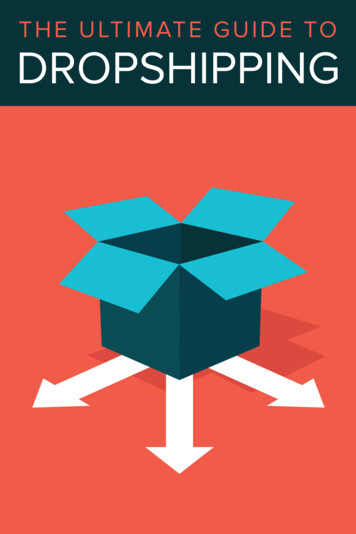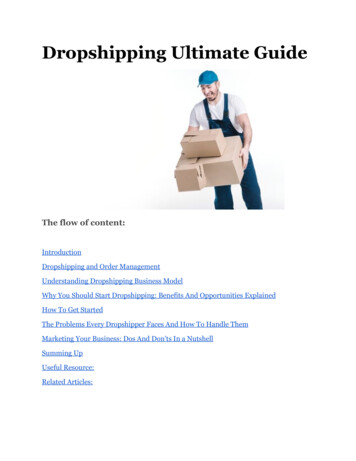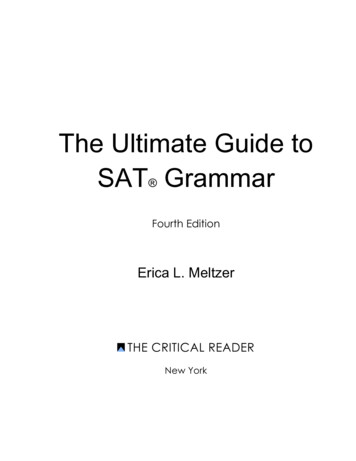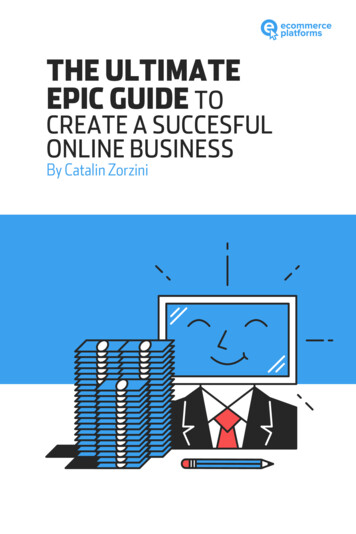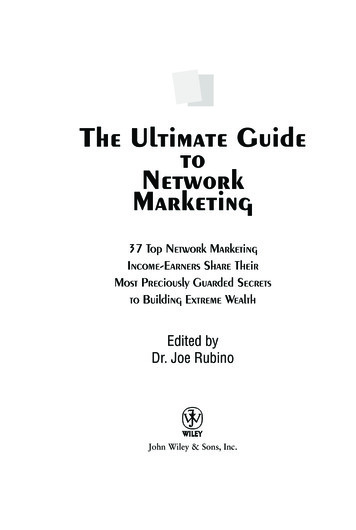
Transcription
The 2018Ultimate Guide toMachine Learning forEmbedded Systems
Table of ContentIntroduction 3Embedded AI – Delivering results, managingconstraints 4Machine learning: the lab vs the real world9How to Succeed with Machine Learning15Machine Learning for Embedded Software isNot as Hard as you Think 18Start here! 22Copyright 2018 Reality AI All Rights ReservedPage 2
IntroductionWhat is machine learning for embedded systems?Machine learning is a subfield of Artificial Intelligence which gives computers an abilityto learn from data in an iterative manner using different techniques. Our aim here beingto learn and predict from data.This is a big diversion from other fields which poses the limitation of programming instructions instead of learning from them.Machine Learning in Embedded Systems specifically target embedded systems to gather data, learn and predict for them. These systems typically consist of low memory, lowRam and minimal resources compared to our traditional computers.So now you know a little more about what we mean by “machine learning for embeddedsystems”, but maybe you’re still unsure about where or how to start?That’s why we’ve created the 2018 ultimate guide to machine learning for embeddedsystems.Enjoy your reading and don’t hesitate to get in touch with us if you have any questions!Copyright 2018 Reality AI All Rights ReservedPage 3
Embedded AI –Delivering results,managing constraintsCopyright 2018 Reality AI All Rights ReservedPage 4
“It’s not who I amunderneath, butwhat I do that defines me.”-BatmanCopyright 2018 Reality AI All Rights ReservedPage 5
Over the last few years, as sensor and MCU prices plummeted and shipped volumeshave gone thru the roof, more and more companies have tried to take advantage by adding sensor-driven embedded AI to their products.Automotive is leading the trend – the average non-autonomous vehicle now has 100sensors, sending data to 30-50 microcontrollers that run about 1m lines of code andgenerate 1TB of data per car per day. Luxury vehicles may have twice as many, and autonomous vehicles increase the sensor count even more dramatically.But it’s not just an automotive trend. Industrial equipment is becoming increasingly“smart” as makers of rotating, reciprocating and other types of equipment rush to addfunctionality for condition monitoring and predictive maintenance, and a slew of newconsumer products from toothbrushes, to vacuum cleaners, to fitness monitors add instrumentation and “smarts”.Real-time, at the edge, and a reasonable price pointWhat these applications have in common is the need to use real-time, streaming, complex sensor data – accelerometer, vibration, sound, electrical and biometric signals – tofind signatures of specific events and conditions, or detect anomalies, and do it locallyon the device: with code that runs in firmware on a microcontroller that fits the product’sprice point.When setting out to build a product with these kinds of sensor-driven smarts, there arethree main challenges that need to be overcome:Simultaneous Challenges when using Sensors with Embedded AI:Variation in target and backgroundReal-time detectionConstraints – size, weight, power consumption, priceThe first is Variation.Real world data is noisy and full of variation – meaning that the things you’re looking for may look different in different circumstances. You will face variation in yourtargets (want to detect sit-ups in a wearable device? First thing you will hit is thatpeople do them all slightly differently, with myriad variations). But you will also facevariation in backgrounds (vibration sensors on industrial equipment will also pick upvibrations transmitted thru the structure from nearby equipment). Background variation can sometimes be as important as target variation, so you’ll want to collect bothexamples and counter-examples in as many backgrounds as possible.The second is Real-time detection in firmware.The need to be able to accomplish detections locally that provide a user with a “reCopyright 2018 Reality AI All Rights ReservedPage 6
al-time” experience, or to provoke a time-sensitive control response in a machine,adds complexity to the problem.The third is Constraints – physical, power, and economic.With infinite computing power, lots of problems would be a lot easier. But real-worldproducts have to deliver within a combination of form factor, weight, power consumption and cost constraints.Traditional Engineering vs Machine LearningTo do all of this simultaneously, overcome variation to accomplish difficult detections inreal-time, at the edge, within the necessary constraints is not at all easy. But with moderntools, including new options for machine learning on signals (like Reality AI) it is becoming easier.Certainly, traditional engineering models constructed with tools like Matlab are a viableoption for creating locally embeddable detection code. Matlab has a very powerful signal processing toolbox which, in the hands of an engineer who really knows what she isdoing, can be used to create highly sophisticated, yet computationally compact, modelsfor detection.Why use Machine Learning?But machine learning is increasingly a tool of choice. Why?For starters, the more sophisticated machine learning tools that are optimized for signalproblems and embedded deployment (like Reality AI) can cut months, or even years,from an R&D cycle. They can get to answers quickly, generating embeddable code fast,allowing product developers to focus on their functionality rather than on the mathematics of detection.But more importantly, they can often accomplish detections that elude traditional engineering models. They do this by making much more efficient and effective use of data toovercome variation. Where traditional engineering approaches will typically be based ona physical model, using data to estimate parameters, machine learning approaches canlearn independently of those models. They learn how to detect signatures directly fromthe raw data and use the mechanics of machine learning (mathematics) to separate targets from non-targets without falling back on physics.Different Approaches for Different ProblemsIt is also important to know that there are several different approaches to machine learning for this kind of complex data. The one getting most of the press is “Deep Learning”,a machine learning method that uses layers of convolutional and/or recurrent neuralCopyright 2018 Reality AI All Rights ReservedPage 7
networks to learn how to predict accurately from large amounts of data. Deep Learninghas been very successful in many use cases, but it also has drawbacks – in particular,that it requires very large data sets on which to train, and that for deployment it typicallyrequires specialized hardware ( ). Other approaches, like the one we take at RealityAI, may be more appropriate if your deployment faces cost, size or power constraints.Three things to keep in mind when building products with embedded AIIf you’re thinking of using machine learning for embedded product development, thereare three things you should understand:1. Use rich data, not poor data. The best machine learning approaches work bestwith information-rich data. Make sure you are capturing what you need.2. It’s all about the features. Once you have good data, the features you choose toemploy as inputs to the machine learning model will be far more important thanwhich algorithm you use.3. Be prepared for compromises and tradeoffs. The sample rate at which you collect data and the size of the decision window will drive much of the requirementsfor memory and clock-speed on the controller you select. But they will also affectdetection accuracy. Be sure to experiment with the relationship between accuracy,sample rate, window size, and computational intensity. The best tools in the marketwill make it easy for you to do this.Copyright 2018 Reality AI All Rights ReservedPage 8
Machine Learning:Lab vs Real WorldCopyright 2018 Reality AI All Rights ReservedPage 9
“In theory there’s nodifference betweentheory and practice.In practice there is.”-Yogi BerraCopyright 2018 Reality AI All Rights ReservedPage 10
Not long ago, TechCrunch ran a story reporting on Carnegie Mellon research showingthat an “Overclocked smartwatch sensor uses vibrations to sense gestures, objects andlocations.” These folks at the CMU Human-Computer Interaction Institute had apparentlymodified a smartwatch OS to capture 4 kHz accelerometer waveforms (most wearabledevices capture at rates up to 0.1 kHz), and discovered that with more data you coulddetect a lot more things. They could detect specific hand gestures, and could even tell awhat kind of thing a person was touching or holding based on vibrations communicatedthru the human body. (Is that an electric toothbrush, a stapler, or the steering wheel ofa running automobile?”)“Duh!”To those of us working in the field, including those at Carnegie Mellon, this was no greatrevelation. “Duh! Of course, you can!” It was a nice-but-limited academic confirmationof what many people already know and are working on. TechCrunch, however, in typicalbreathless fashion, reported as if it were news. Apparently, the reporter was unawareof the many commercially available products that perform gesture recognition (amongthem Myo from Thalmic Labs, using its proprietary hardware, or some 20 others offeringsmartwatch tools). It seems he was also completely unaware of commercially availabletoolkits for identifying very subtle vibrations and accelerometry to detect machines conditions in noisy, complex environments (like our own Reality AI for Industrial EquipmentMonitoring), or to detect user activity and environment in wearables (Reality AI for Consumer Products).But my purpose is not to air sour grapes over lazy reporting. Rather, I’d like to use thiscase to illustrate some key issues about using machine learning to make products forthe real world: Generalization vs Overtraining, and the difference between a laboratorytrial (like that study) and a real-world deployment.Generalization and OvertrainingGeneralization refers to the ability of a classifier or detector, built using machine learning,to correctly identify examples that were not included in the original training set. Overtraining refers to a classifier that has learned to identify with high accuracy the specificexamples on which it was trained, but does poorly on similar examples it hasn’t seenbefore. An overtrained classifier has learned its training set “too well” – in effect memorizing the specifics of the training examples without the ability to spot similar examplesagain in the wild. That’s ok in the lab when you’re trying to determine whether somethingis detectable at all, but an overtrained classifier will never be useful out in the real world.Typically, the best guard against overtraining is to use a training set that captures asmuch of the expected variation in target and environment as possible. If you want todetect when a type of machine is exhibiting a particular condition, for example, includeCopyright 2018 Reality AI All Rights ReservedPage 11
in your training data many examples of thattype of machine exhibiting that condition, andexhibiting it under a range of operating conditions, loads, etc.It also helps to be very skeptical of “perfect”results. Accuracy nearing 100% on small sample sets is a classic symptom of overtraining.It’s impossible to be sure without looking moreclosely at the underlying data, model, and validation results, but this CMU study shows classic signs of overtraining. Both the training andvalidation sets contain a single example ofeach target machine collected under carefully controlled conditions. And to validate, theyappear to use a group of 17 subjects holdingthe same single examples of each machine.In a nod to capturing variation, they have eachsubject stand in different rooms when holdingthe example machines, but it’s a far cry fromthe full extent of real-world variability. Their result has most objects hitting 100% accuracy,with a couple of objects showing a little lower.Small sample sizes. Reuse of training objectsfor validation. Limited variation. Very high accuracy. Classic overtraining.Illustration from the CMU study using vibrations captured with an overclocked smartwatch to detect what object a person is holding.Detect overtraining and predict generalizationIt is possible to detect overtraining and estimate how well a machine learning classifieror detector will generalize. At Reality AI, our go-to diagnostic is the K-fold Validation,generated routinely by our tools.K-fold validation involves repeatedly 1) holding out a randomly selected portion of thetraining data (say 10%), 2) training on the remainder (90%), 3) classifying the holdoutdata using the 90% trained model, and 4) recording the results. Generally, hold-outs donot overlap, so, for example, 10 independent trials would be completed for a 10% holdout. Holdouts may be balanced across groups and validation may be averaged over multiple runs, but the key is that in each iteration the classifier is tested on data that was notpart of its training. The accuracy will almost certainly be lower than what you computeby applying the model to its training data (a stat we refer to as “class separation”, ratherCopyright 2018 Reality AI All Rights ReservedPage 12
than accuracy), but it will be a much better predictor of how well the classifier will perform in the wild – at least to the degree that your training set resembles the real world.Counter-intuitively, classifiers with weaker class separation often hold up better in K-fold.It is not uncommon that a near perfect accuracy on the training data drops precipitously in K-fold while a slightly weaker classifier maintains excellent generalization performance. And isn’t that what you’re really after? Better performan
Machine Learning in Embedded Systems specifically target embedded systems to gath-er data, learn and predict for them. These systems typically consist of low memory, low Ram and minimal resources compared to our traditional computers. So now you know a little more about what we mean by “machine learning for embedded systems”, but maybe you’re still unsure about where or how to start .


